Sales professionals who use LinkedIn for social selling report 45% more opportunities than their peers. Yet many struggle to create posts that drive replies, meetings, and pipeline.
This guide shows you a repeatable system to create engaging LinkedIn content. You’ll learn how to use PhantomBuster to collect engagement data, spot patterns in top-performing posts, and apply our PACT framework in ChatGPT to write posts that resonate with your target audience.
The anatomy of an effective prompt: The PACT framework
Great outputs start with complete prompts. Include purpose, audience, context, and tone (PACT) to shape the post you want.
For LinkedIn specifically, we’ve developed the PACT framework to help your prompts yield content that builds genuine authority:
P – Purpose: Define the specific objective of your post. Is it to showcase expertise, share an insight, start a conversation, or highlight a client success? Each purpose requires different content structures and approaches.
A – Audience: Specify exactly who you’re writing for in your niche. The more detailed your audience definition, the more targeted your content will be. Include their LinkedIn presence, role, industry, pain points, and goals.
C – Context: Provide relevant background information, including data points, personal experiences, or industry trends that make your post timely and relevant.
T – Tone & Template: Define your unique voice and the structural format you want for your post. Select a tone (professional, bold, or conversational) and a format (listicle, story, case study) to amplify your brand voice.
Here’s an example comparing a basic prompt with a PACT-optimized prompt:
Basic prompt:
Write a LinkedIn post about CRM implementation challenges.
The outcome:
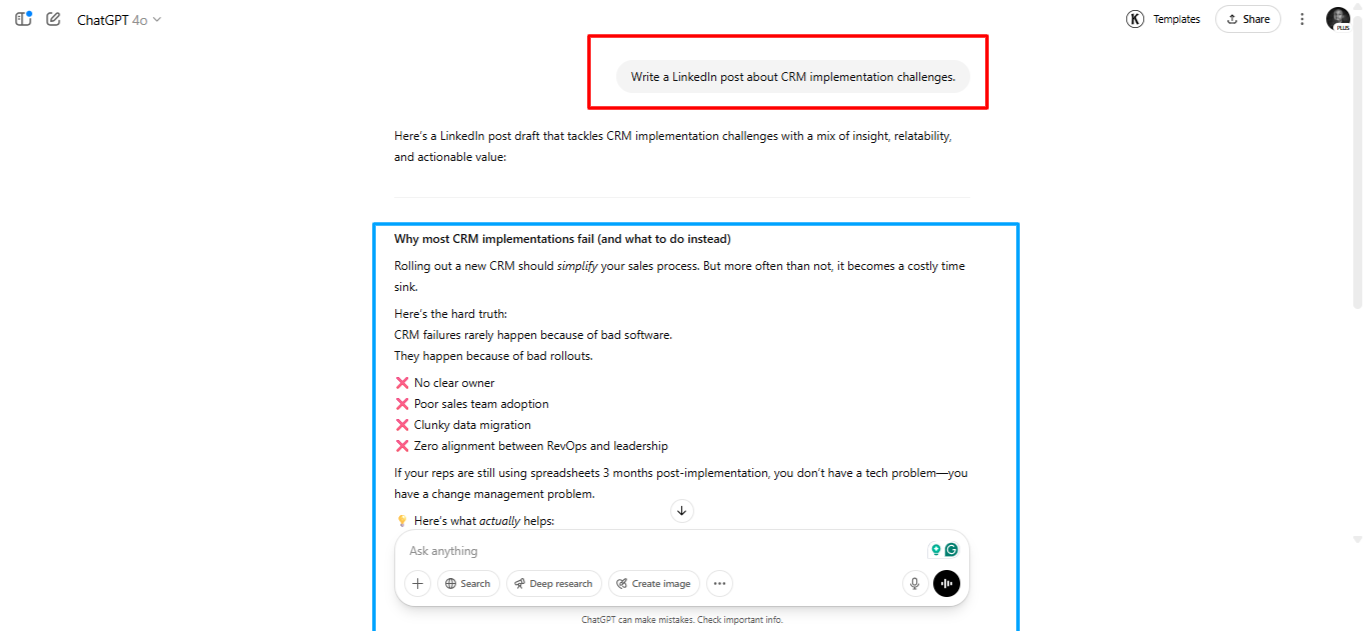
PACT-optimized prompt:

Purpose: Write a LinkedIn post that positions me as a problem-solver while generating conversation about common CRM challenges. Audience: Sales directors and VPs of Sales at mid-market B2B SaaS companies (50-200 employees) who are considering implementing a new CRM system. They’re concerned about user adoption, data migration, and ROI timeframes. Context: I’ve helped 12 companies implement Salesforce in the last year. The most common challenge was getting the sales team to actually use the system consistently. On average, it took 3 months to reach 80% adoption rates. Tone & Template: Conversational and empathetic but authoritative. Start with a provocative question, share 2-3 specific challenges with brief solutions, and end with an open-ended question that invites comments. Keep paragraphs to 1-2 sentences for readability.
The PACT framework helps your prompts include the elements ChatGPT needs to produce thought-provoking posts that connect with your specific audience. You’ll use it to guide the data you collect next.
Below is an output of the prompt above:
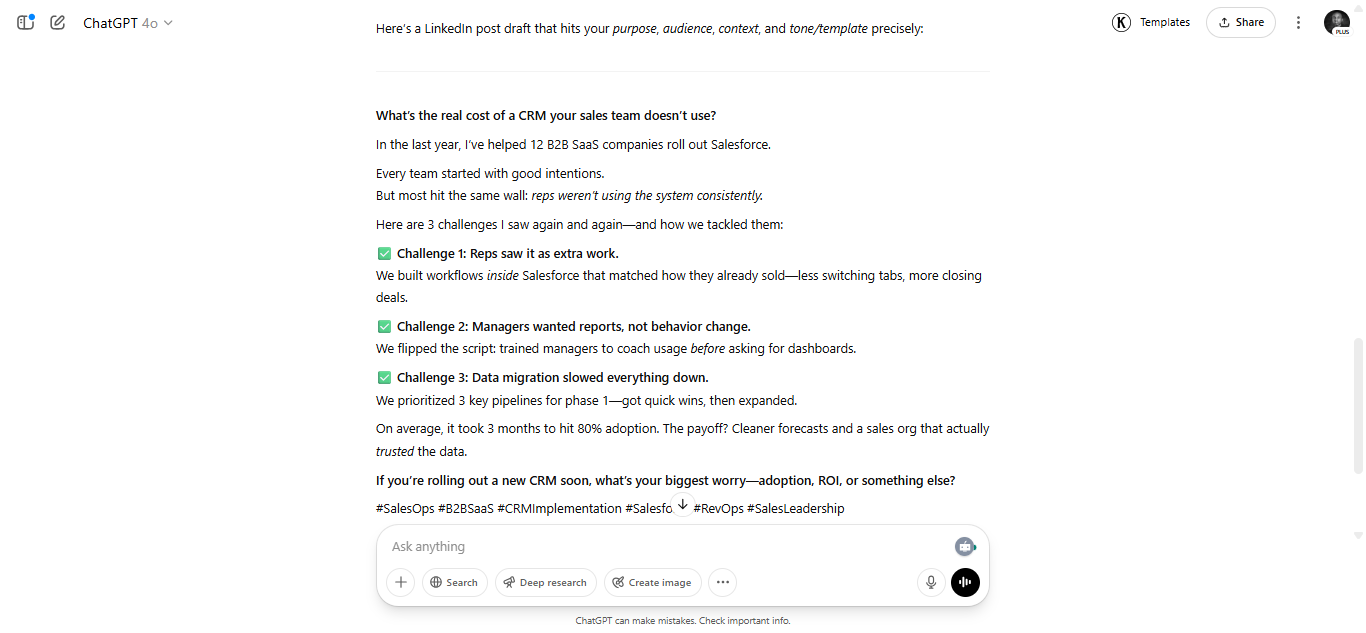
How to use engagement data to write better LinkedIn posts
1. Extract your LinkedIn data with PhantomBuster
Creating great content starts with understanding what’s already resonating with your ideal customer profile. That means gathering data on what topics drive engagement, what formats your audience responds to, and what fizzles out.
Analyzing LinkedIn engagement manually is tedious. You might miss subtle patterns, key topics, or content formats consistently driving results.
Use PhantomBuster’s LinkedIn Activity Extractor automation to export your recent posts with likes, comments, and timestamps into a sheet, so you can spot patterns fast.
2. Analyze your content performance patterns with ChatGPT
With your CSV file of LinkedIn data in hand, the next move is pattern recognition. Start by reviewing your top 10–15 posts by engagement. Focus on likes, comments, and impressions.
Ask: Are specific topics consistently performing better? Does a particular post format (e.g., storytelling, list, quote) get more traction?
Export from PhantomBuster to a CSV or Google Sheet, then paste summaries into ChatGPT with this prompt:
Example prompt:
I want to analyze my LinkedIn content performance. Here are details about my top 10 performing posts: Post 1: [Brief description, engagement metrics, content type] Post 2:[Continue with all posts] Based on this data, please: 1. Identify patterns in my most successful content (themes, formats, length, etc.) 2. Note what type of hooks seem to work best 3. Determine what content themes generate the most meaningful engagement 4. Suggest content types I should focus on based on this data and marketing channel 5. Recommend content types I should reduce or eliminate Please organize your analysis in a clear, structured format.
This analysis will reveal what’s working for your specific audience, forming the foundation of your personal brand and data-driven content strategy.
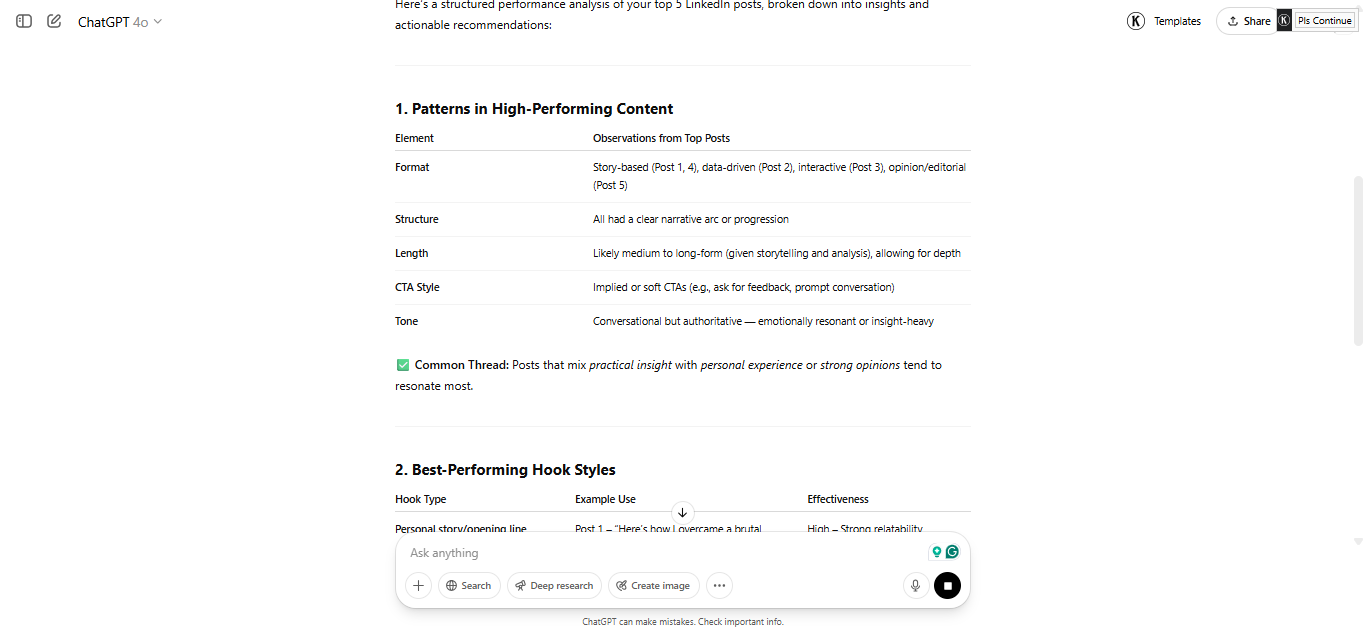
You can also ask ChatGPT to design a simple tracking sheet:
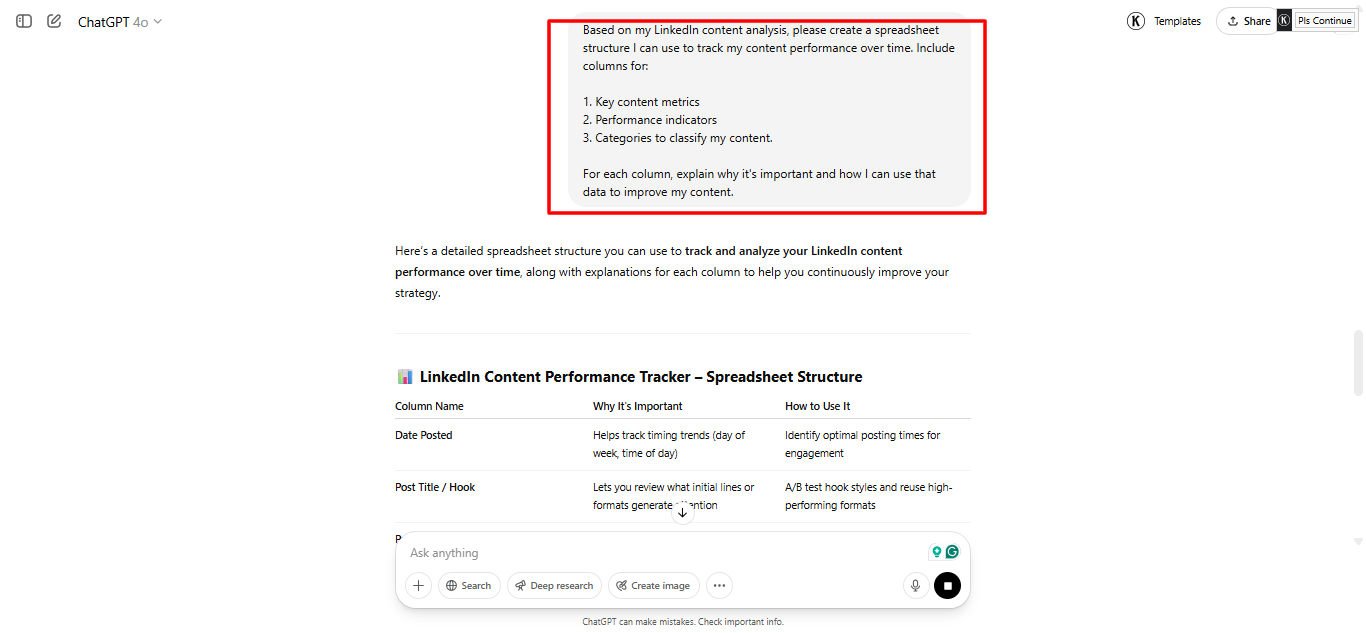
3. Research your industry and competitors with PhantomBuster and ChatGPT
Analyzing top-performing competitor and influencer posts reveals insights you might be overlooking. Select five to 10 relevant profiles, ranging from competitors to thought leaders in sales, to analyze the responses generated.
Scan their top posts (top 10% by reactions and comments) and note the hook type, topic, post length, and call to action. Use automation to speed this up.
Use PhantomBuster’s LinkedIn Post Commenter and Liker Scraper automation to extract commenter and liker details (e.g., job titles and comments) into a sheet, so you can analyze audience sentiment. Use responsibly and follow LinkedIn’s guidelines. Avoid unsolicited outreach to these contacts.
After the automation runs, review the CSV to identify roles, topics, and objections that keep appearing. Only analyze public data, respect privacy, and avoid unsolicited outreach to commenters.
Next, feed these insights into ChatGPT for a comparative analysis. Prompt it to highlight patterns, common hooks, audience tone, and key engagement drivers that you can incorporate into your strategy.
I’ve extracted engagement data from top-performing LinkedIn posts by industry influencers. Please analyze this information to help inform my content strategy: Influencer 1: [Name/role] Post topic: [Brief description] Engagement: [Key metrics] Common themes in comments: [Brief summary of comment themes] [Repeat for 2-3 more influencers] Based on this data, please: 1. Identify trending topics in my industry that generate high engagement 2. Analyze what content formats are performing best 3. Highlight audience pain points revealed in the comments 4. Suggest content opportunities I could address 5. Recommend specific topics that would position me as an authority Also, what patterns do you see across these successful posts that I could apply to my own content?
This analysis gives you valuable insights into what’s resonating in your industry right now. This way, you can create content that’s relevant to your audience’s current interests.
Ready to analyze your posts? Try PhantomBuster’s LinkedIn Activity Extractor automation to build your dataset.
4. Create your content strategy document with ChatGPT
With data from your posts and competitor research, use ChatGPT to develop a comprehensive content strategy. You’ll stop guessing. You’ll have a bank of ideas and formats mapped to clear goals.
Example prompt:
Based on my LinkedIn content analysis and competitor research, I’ve found: My top-performing content: – [List 2-3 content types or themes that work best for you] – [List engagement patterns you’ve observed] Industry trends: – [List 2-3 trending topics and trending content formats in your industry] My audience interests: – [List 2-3 pain points or questions from comments] Please create a comprehensive LinkedIn content strategy document that includes: 1. 3-5 content pillars that align with my expertise and audience interests 2. Content mix recommendations (types of posts and their frequency) 3. A voice and tone guide based on what resonates with my audience 4. Content series ideas that could establish my authority 5. A basic weekly posting schedule Format this as a clear, actionable document I can reference when creating content. The resulting document will serve as your content roadmap, ensuring everything you post contributes to your authority-building goals.
The resulting document will serve as your content roadmap, ensuring everything you post contributes to your authority-building goals.
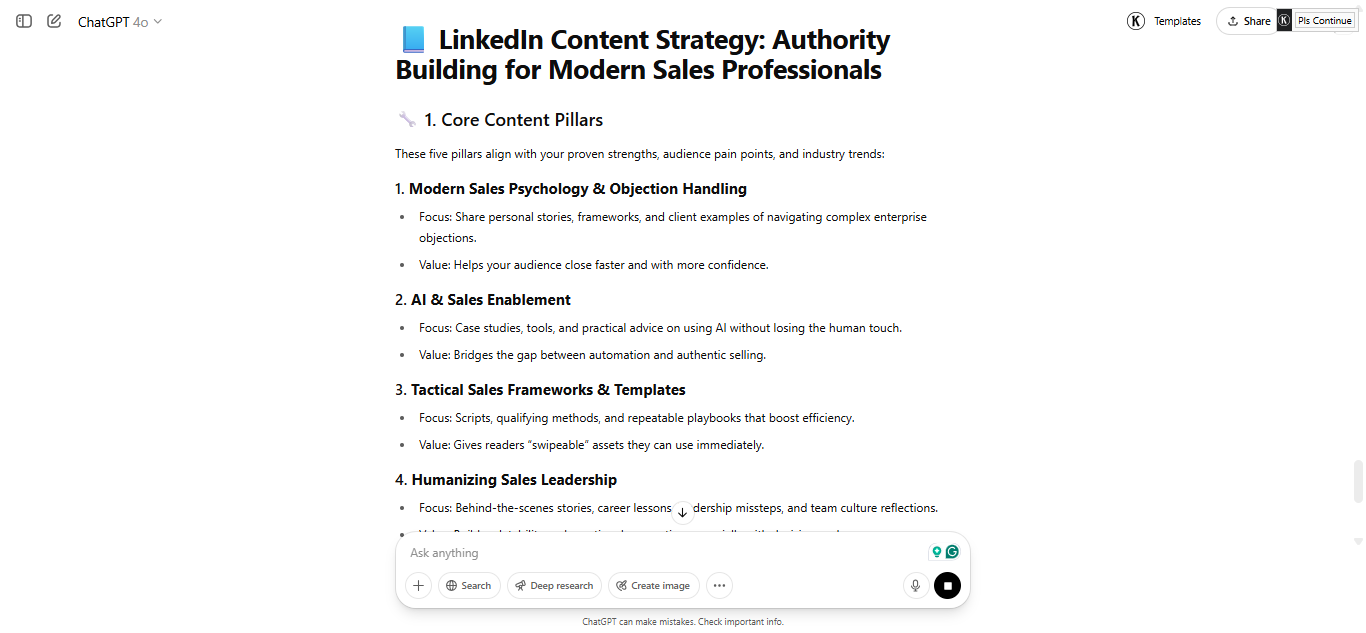
5. Develop your PACT-optimized prompt template
With your content strategy in place, it’s time to create a master prompt template based on the PACT framework that incorporates all your data insights. Fill in each section based on your content strategy and data analysis.
This template uses your data, so it fits your audience, not generic best practices.
Here’s a template you can customize:
Purpose: Create a LinkedIn post that [specific objective tied to your content pillars]. Audience: [Detailed description of your target audience based on your research, including their role, industry, pain points, and goals] Context: [Relevant background information, data points, or a personal story that make this post timely and valuable] Tone & Template: [Your unique voice characteristics] Format the post as follows: – Hook: [Specify the type of hook that works best based on your data] – Body: [Structure based on what performs well for you] – Call to action: [The type of engagement you want to encourage] Additional guidelines: – Include [specific elements that increase engagement based on your research] – Avoid [things that don’t work well for your audience] – Optimal length: [Based on your data analysis]
6. Generate and refine high-quality LinkedIn posts
Now that your template is set, it’s time to create engaging posts. Select a topic from your content strategy that matches your defined content pillars. Then, fill your master template with details relevant to that chosen topic.
Next, input this customized prompt into ChatGPT to generate your first draft. Review the AI-generated content carefully and look for opportunities to personalize it further. Consider adding real-life experiences, industry-specific insights, or your distinct viewpoint.
Here’s an example of a completed prompt and the resulting output:
Completed prompt:
Purpose: Write a LinkedIn post positioning me as a sales tech expert, offering practical advice to sales ops leaders overwhelmed by tech choices. It should be informative content Audience: Mid-market B2B sales ops as Nd tech industry leaders (50–500 employees), struggling with tool overload and effectiveness. Context: I recently streamlined a client’s sales tech from 14 to 7 tools, boosting productivity by 23% and saving $120K annually by prioritizing integration and adoption over features. Tone & Template: Conversational yet authoritative. Hook: Start with a surprising stat or bold statement on sales tech. Body: Share 2–3 actionable insights from my experience, including specific results. CTA: End by asking about their top sales tech challenges. Additional guidelines: Keep paragraphs short (1–2 sentences). Use clear numbers/results. Avoid jargon. Optimal length: 150–200 words.
ChatGPT output:
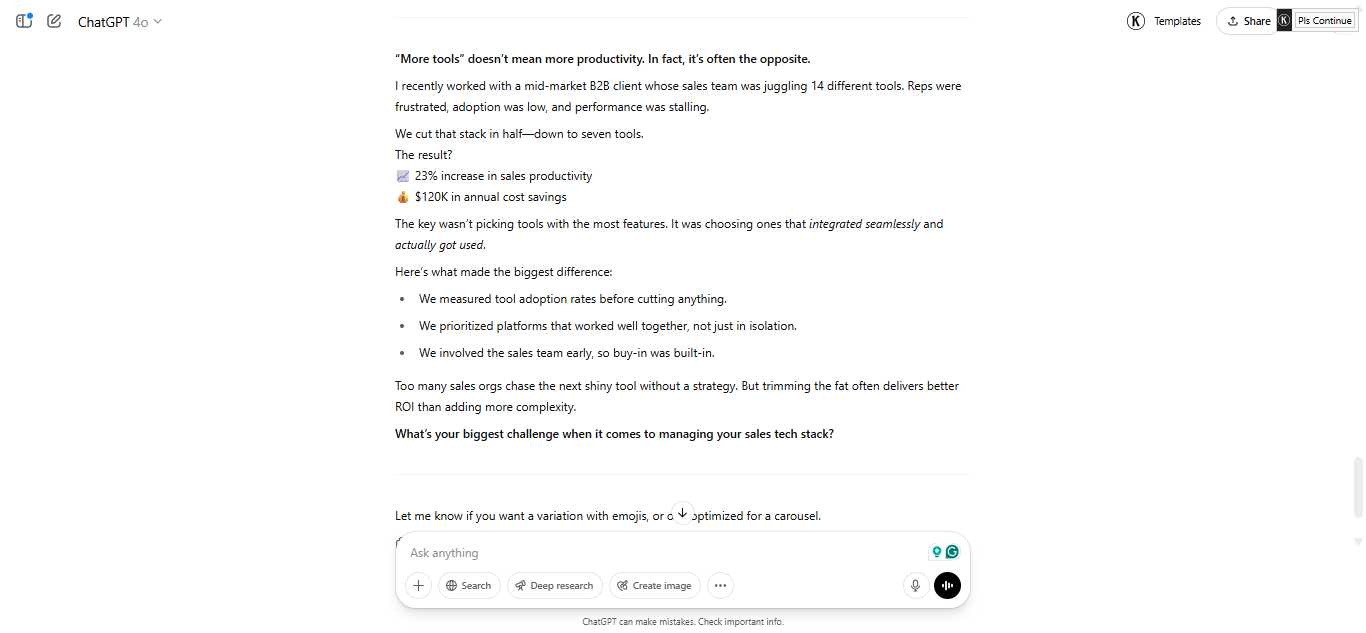
After generating this initial draft, review and edit it to add your personal touch and ensure it aligns with your voice and expertise.
The output of this step is a polished, ready-to-publish LinkedIn post.
7. Measure, learn, and iterate
After posting, monitor key metrics like:
- Engagement (likes, comments, and shares)
- Profile views and connection requests
- Prospect messages and SSI score impact
Then ask: What performed better than expected? What fell flat? Use those insights to adjust your strategy and refine your prompts. Repeat this review monthly to keep improving results. That’s how you turn AI posts into consistent pipeline drivers.
Use this ChatGPT prompt to analyze results and beat writer’s block:
I’ve been tracking the performance of my LinkedIn posts for the past [timeframe]. Here’s what I’ve observed: – Posts about [topic] are generating [result] – [Format type] posts are receiving [engagement pattern] – Comments tend to focus on [theme] Based on this data, how should I refine my content strategy and prompt template to improve engagement and authority-building?
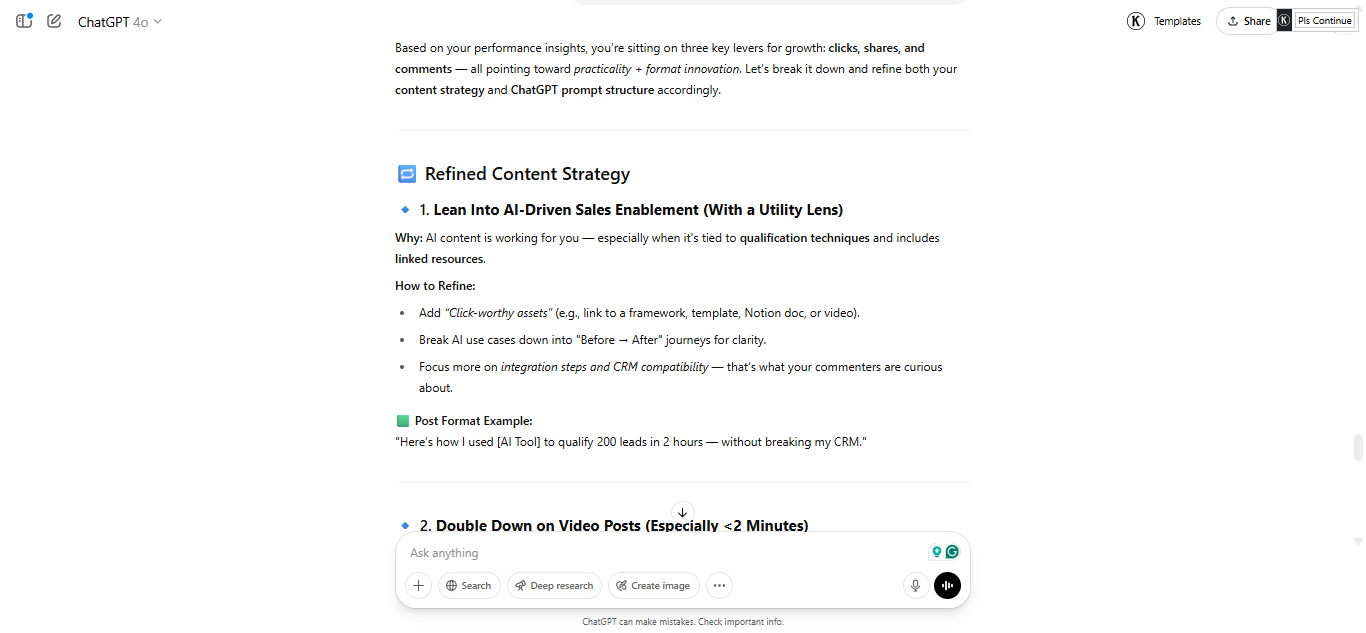
Keep optimizing your LinkedIn content. Use PhantomBuster’s LinkedIn Activity Extractor to track what’s working.
Quick LinkedIn post-generation prompts based on existing resources
While the full workflow above will give you the best results over time, sometimes you need to create content quickly based on existing materials.
Below are prompts you can adapt to turn existing materials into engaging posts:
Pro tip: For best results, customize these prompts with your audience details and tone (PACT).
Prompts for repurposing blog articles
Use this when you have a blog post or article and want to extract one key insight for LinkedIn.
Transform this blog excerpt into a LinkedIn post that positions me as a thought leader. Focus on ONE key insight, start with a provocative statement, and end with a question that sparks conversation. Format with 1-2 sentence paragraphs for mobile readability. Keep under 200 words. Blog excerpt: [Paste 200-300 words] My audience: [Specific description] My connection to this topic: [Brief personal angle]
Example input: Blog excerpt about sales productivity methods and metrics
Example output: We tested the prompt with our details, and here’s what we got.
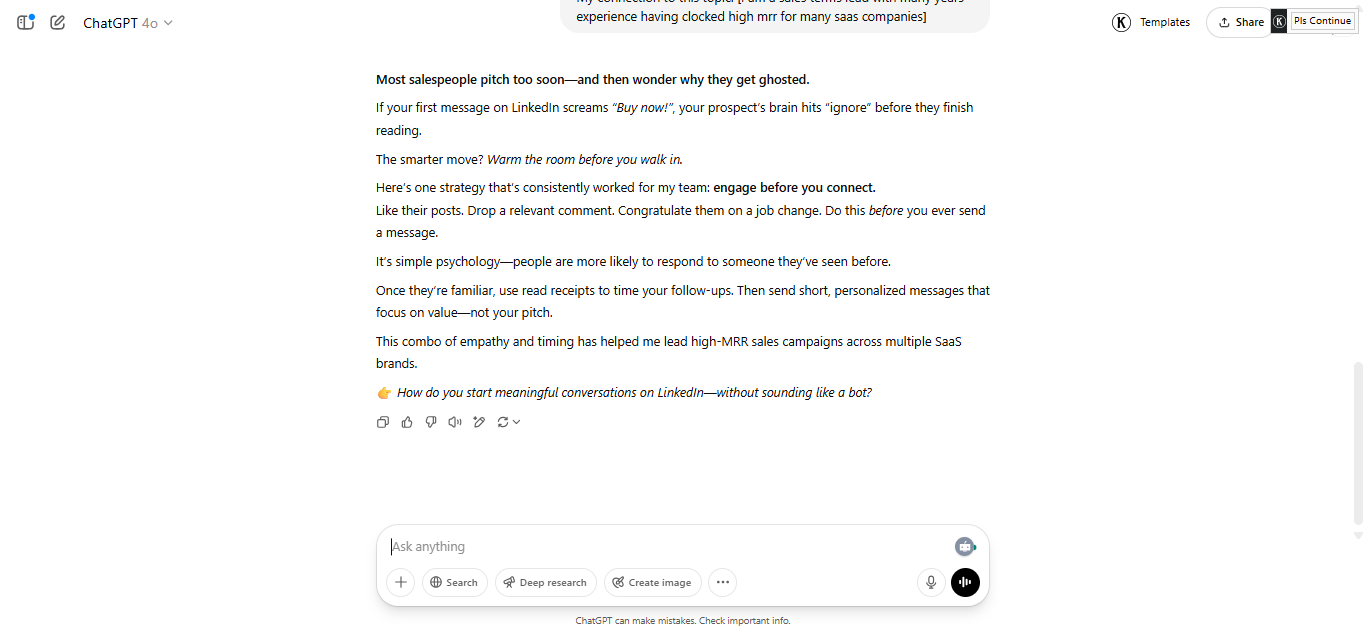
Prompts for transforming podcast/video content
Use this when you’ve recorded a podcast episode or video and want to share the most valuable takeaway on LinkedIn.
Convert the following key points from my [podcast/video] into a thought-provoking LinkedIn post. Focus on the most valuable insight rather than summarizing everything. Format the post to be highly readable on mobile with short paragraphs. Include a relevant personal experience that adds credibility, and end with a question that invites discussion. Key points from [podcast/video title]: 1. [Point 1] 2. [Point 2] My personal experience related to this topic: [Brief note about your experience] My audience consists of [specific roles, challenges they face, what they care about]. Tone: [Describe your preferred tone – authoritative, conversational, bold, etc.]
Example output:
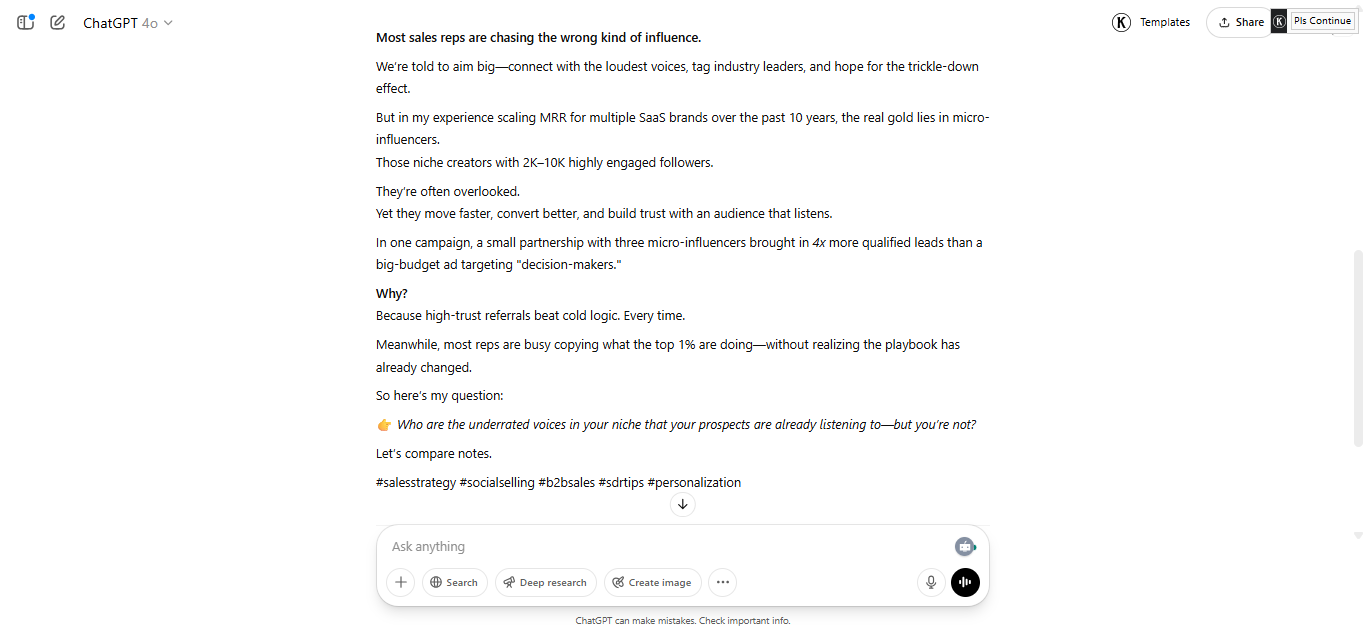
Prompts for sharing industry research and reports
Use this when you’ve read an industry report or study and want to share a key finding with your perspective.
Help me create a LinkedIn post highlighting a key finding from this industry research. Focus on one surprising statistic or trend that would be most relevant to [your specific audience]. The post should position me as an informed industry leader who can interpret data meaningfully for my network. Research summary: [Include 3-5 key findings from the research] My perspective: [Add a brief note about your take on this research] Format guidelines: – Begin with the most compelling statistic or finding – Provide brief context on why this matters – Include 1-2 sentences on practical implications – End with a thoughtful question – Use short paragraphs for readability
Example output:
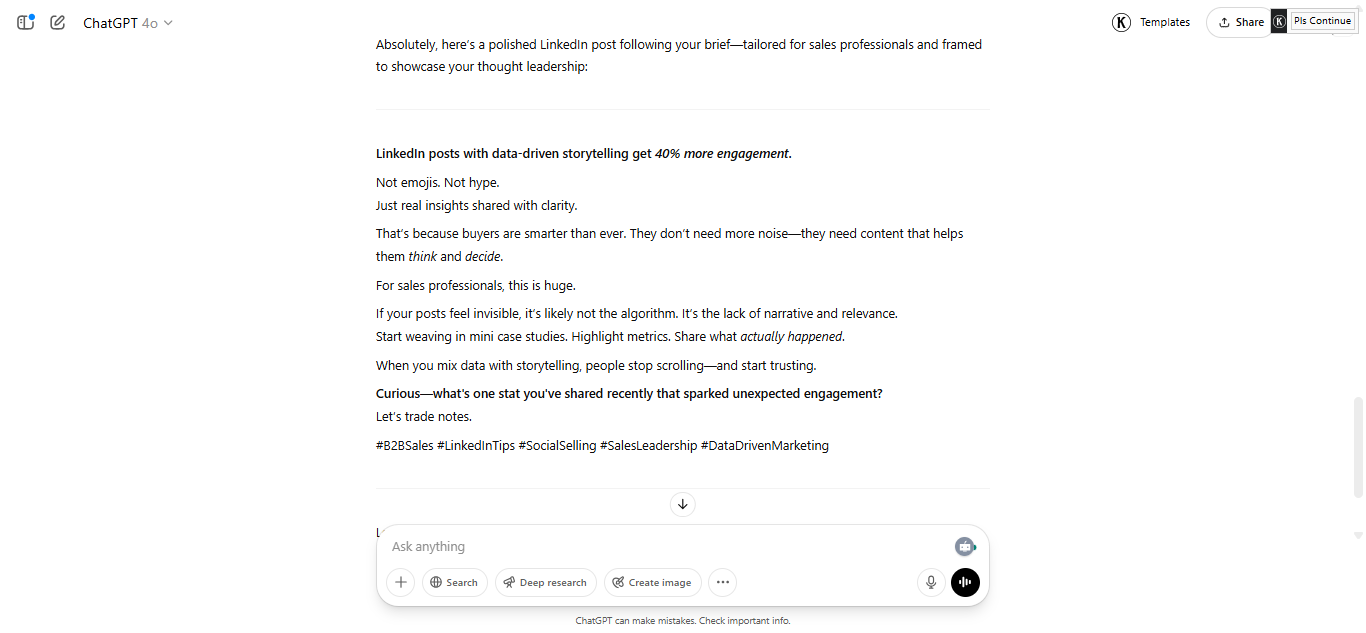
Prompts for case study and client success stories
Use this when you want to share a client win while protecting confidentiality and offering value to your network.
Help me transform the following client success story into an engaging LinkedIn post. Focus on the challenge, solution, and results while protecting client confidentiality. The post should demonstrate my expertise without being self-promotional, and should offer a valuable lesson or insight that others in my network can apply. Client industry: [Industry] Challenge: [Brief description] Solution: [Brief description] Results: [Specific metrics if available] Key learning: [Main takeaway] Post format preferences: – Begin with an attention-grabbing statement or question – Present the challenge in a way that resonates with others in similar situations – Briefly explain the approach (without revealing proprietary methods) – Highlight concrete results – Share the broader lesson/takeaway – End with a question that encourages readers to share their experiences
Example input:
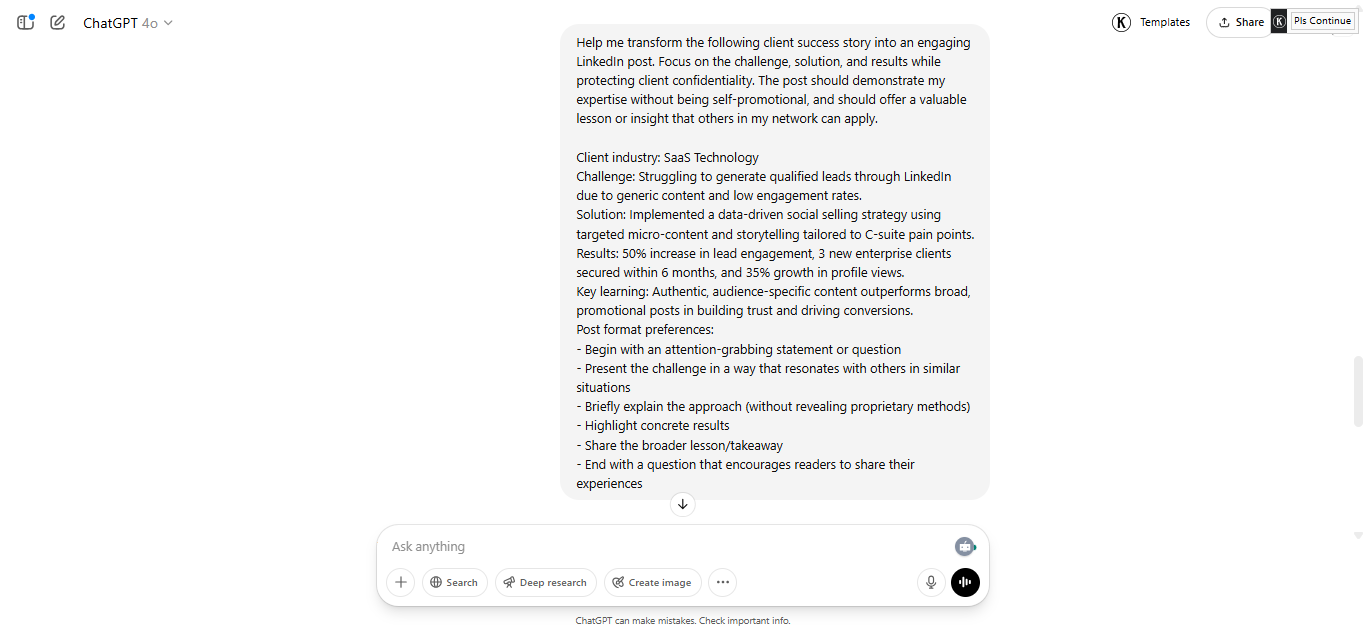
Example output:
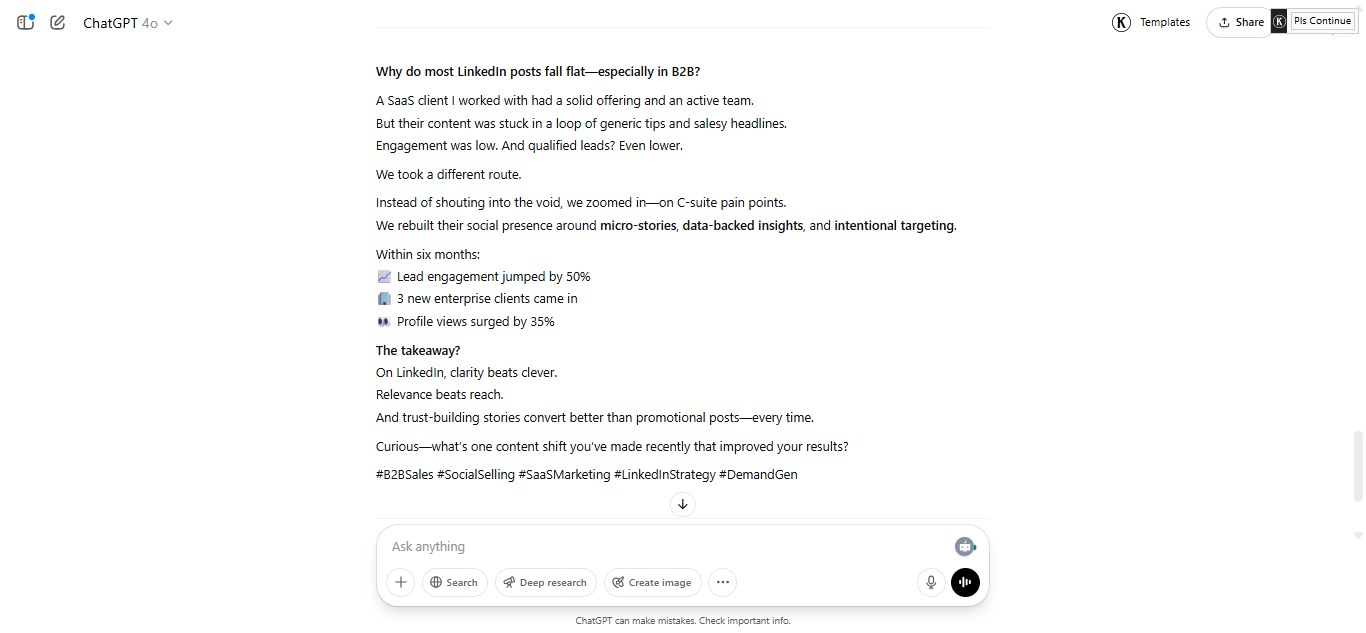
Prompts for personal experiences and lessons learned
Use this when you have a professional experience or mistake that taught you something valuable your audience can learn from.
Help me craft a LinkedIn post about a personal professional experience or lesson that will resonate with my audience of [specific description of audience with their challenges]. The story should be authentic, include a specific situation I faced, and draw out a valuable lesson that others can apply. Experience/Lesson: [Brief description of your experience] Situation: [Specific example or context] Challenge/Mistake: [What went wrong or what obstacle you faced] Resolution: [How you addressed it] Learning: [The takeaway that others can apply] Post format preferences: – Start with a hook that draws readers in – Tell the story concisely but with enough detail to be credible – Share the learning in a way that’s helpful – End with a question that invites others to share their experiences
Example output:
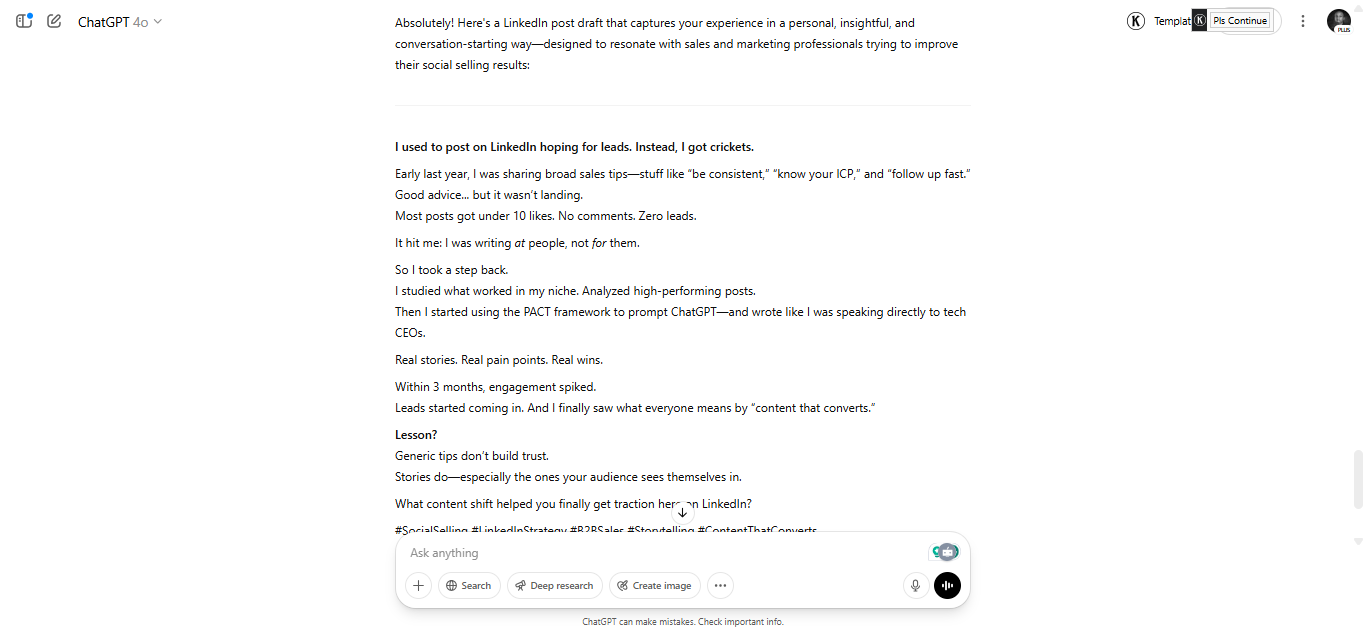
Next-level strategies: Using AI to build your LinkedIn authority
Building content clusters for topic authority
Rather than posting about various topics without connection, focus on creating interconnected content around your core expertise areas. For each cluster, develop a series of posts that build on each other, progressing from foundational concepts to advanced insights.
You can use this prompt to generate content cluster ideas:
Prompt for content cluster ideas: Based on my expertise in [your field], help me develop 3-4 content clusters that would establish me as an authority. For each cluster, suggest 5-7 specific post topics that build on each other, starting with foundational concepts and moving toward sophisticated insights. My target audience is [audience description].
Maintaining authenticity while using AI
Create a detailed voice guide capturing your unique communication style, incorporate personal anecdotes from real client interactions, use AI as a thought partner (not a content creator), and develop a consistent review process to personalize all outputs.
I want to ensure my AI-assisted LinkedIn content maintains my authentic voice. Based on the following examples of my writing, help me create a detailed voice guide that captures my unique communication style, common phrases, tone, and perspective.
Examples of my writing:
[Include 3-5 paragraphs that represent your voice]Please identify:
1. Common phrases and word choices
2. Sentence structure patterns
3. Tone characteristics
4. Unique perspectives or angles I tend to take
5. Types of examples I typically use
The key is to view AI as an enhancer of your voice rather than a replacement for it.
Analyzing engagement to discover content opportunities
One of the most valuable sources of content ideas comes from the comments on your own posts and those of industry influencers.
Use PhantomBuster’s LinkedIn comment-extraction automations to pull comments from high-performing posts, then analyze patterns: common questions, pain points, and insights.
You can use ChatGPT to help analyze large volumes of comment data with this prompt:
I’ve extracted comments from several high-performing LinkedIn posts in my industry. Please analyze these comments to identify: 1. Common questions or pain points mentioned 2. Topics that generate the most debate or discussion 3. Areas where people are asking for more information 4. Types of personal experiences being shared Comments: [Paste 20-30 comments from various posts] Based on this analysis, what content opportunities do you see? What topics should I consider for future posts that would address these clear interests or needs?
Creating a content series that establishes expertise
While individual posts can demonstrate knowledge, strategic content series establish deep expertise and position you as the definitive voice on a topic.
High-converting formats include framework breakdowns (like “The Five Pillars of Sales Coaching”), process explanations (“The Seven-Step Enterprise Sales Process”), myth-busting series, case study collections, and evolution series that track industry changes. A content series creates anticipation for your next post and provides a structured way to showcase comprehensive expertise on a subject, increasing follower engagement and retention.
You can use this prompt to help design your series:
Help me create a 5-part LinkedIn content series on [topic] for my audience of [audience description]. For each part: 1. Suggest a specific subtopic 2. Outline key points to cover 3. Recommend an attention-grabbing hook 4. Suggest how to link to the previous post 5. Include a teaser for the next post The series should progress logically while each post remains valuable standalone.
Scaling your content creation with sustainable systems
Develop reusable templates for different post types (success stories, industry insights, quick tips, etc.). Practice batch content creation by dedicating focused time blocks to produce two to four weeks of content at once. Build a content library that categorizes your posts and tracks performance metrics to identify what works best.
This prompt can help you create your content templates:
Based on my analysis of successful LinkedIn content in my industry, I’ve identified these high-performing post types: [List 3-5 post types that work well for you] For each type, please create a reusable template that includes: 1. The optimal structure (hook, body, conclusion) 2. Key elements to include 3. Approximate length 4. Types of questions that work well as CTAs These templates should be specific enough to guide my creation process but flexible enough to apply to various topics within my expertise area of [your expertise area].
Common mistakes to avoid when using ChatGPT for LinkedIn
| Mistake | Result | Solution |
|---|---|---|
| Not editing ChatGPT-generated content | Generic, impersonal posts that don’t reflect your voice or expertise | Review all AI outputs and inject your expertise through specific examples and client stories |
| Using the same prompt repeatedly | Predictable, formulaic content that loses audience interest over time | Create a prompt library with five to seven variations for each content type |
| No personal touch or experiences | Content lacks authenticity and credibility, undermining trust | Include personal anecdotes, client stories (anonymized), and specific learnings from your experience |
| Posting without a strategic purpose | Random content that doesn’t build authority in specific areas | Create a content calendar that maps every post to one of your three to four content clusters |
| Ignoring engagement data | Missed opportunities to improve content effectiveness | Implement a monthly content audit comparing your three highest and lowest performing posts to identify patterns that drive engagement |
| Thinking that one prompt is enough | Suboptimal results requiring extensive editing | Develop multi-step prompt sequences that first generate structure, then add detail |
FAQ
Can you use ChatGPT for LinkedIn posts?
Yes, with strategic prompting. Use the PACT framework (Purpose, Audience, Context, Tone) to give ChatGPT the specific information it needs to generate relevant, targeted content for your LinkedIn profile. Use PhantomBuster to collect engagement data so your prompts reflect what your audience responds to.
How do I create LinkedIn posts that stand out using AI?
Use ChatGPT to draft the structure or spark ideas, then refine the output by replacing vague language with concrete examples from your work. The key is combining AI efficiency with your unique perspective to create content that feels both credible and human.
Can I automate LinkedIn posting with AI tools?
Use a scheduler (e.g., Buffer) for timing, but avoid full automation. Prioritize authenticity and follow LinkedIn’s guidelines. PhantomBuster focuses on data collection and enrichment to inform better posts. The most effective approach is assisted creation, where AI handles drafting while you add personal elements and final polish.
How do I balance AI assistance with personal authenticity?
Create a voice guide that captures your writing style and communication style, incorporate specific examples from your experience, and always ask “Would I say this?” when reviewing AI outputs. Consider reading posts aloud before publishing to ensure they sound genuine.
What types of LinkedIn content perform best for sales professionals?
Content that speaks directly to your audience’s challenges and goals tends to perform best. This includes problem-solution posts that tackle specific pain points, case studies that highlight real results, behind-the-scenes looks at your sales process, and counterintuitive takes that challenge industry assumptions.
